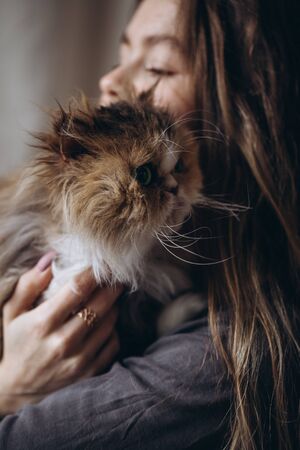Introduction to Popular Cat Breeds in the UK
The United Kingdom has long been a nation of animal lovers, and cats are no exception. Across British households, certain feline breeds have carved out a special place in the hearts of their owners, not just for their charming personalities but also for how well they fit into the unique rhythm of British life. From the elegant British Shorthair with its plush coat and steady temperament to the inquisitive Siamese and the ever-affectionate Ragdoll, these breeds are cherished companions up and down the country. Each breed brings its own quirks and qualities that make it particularly suited to the UKs distinct climate and typical living spaces, whether thats a cosy terraced home in Manchester or a sprawling countryside cottage in Devon. Understanding what makes these popular cats so beloved—and how they thrive in British homes—offers insight into why they remain steadfast favourites among pet owners throughout the UK.
British Climate: Challenges and Advantages for Cats
The United Kingdom is famous for its ever-changing weather, ranging from crisp winter mornings to drizzly autumn afternoons. For cats—especially the popular breeds found across the UK—this temperate and variable climate presents both unique challenges and notable advantages when it comes to behaviour and comfort. Understanding how these beloved felines cope with the British climate can help owners create a more comfortable and enriching environment for their pets.
Adapting to Rain, Chill, and Sunshine
Cats in the UK often encounter frequent rain, damp conditions, and fluctuating temperatures. These factors influence everything from their preferred sleeping spots to their activity levels. Many breeds have developed certain behaviours or physical traits that help them handle these shifts in weather. For instance, you might notice your British Shorthair curling up by a radiator on chilly days or your Bengal seeking sunbeams during rare sunny spells.
Climate Challenges Faced by Cats
| Weather Condition | Potential Challenge | Cat Behaviour/Adaptation |
|---|---|---|
| Frequent Rain | Wet fur and discomfort; reluctance to go outdoors | Increased indoor play; seeking dry, elevated spaces |
| Cold Winters | Chilliness, especially for short-haired or slender breeds | Curling up near heat sources; reduced outdoor activity |
| Dampness/Humidity | Matted fur, risk of fungal infections | More grooming; preference for well-ventilated areas |
| Variable Temperatures | Difficulty maintaining body temperature | Seeking sunny windowsills; moving between rooms for comfort |
| Rare Heatwaves | Overheating risk for long-haired breeds | Panting, stretching out on cool floors; drinking more water |
A Silver Lining: The Benefits of the UKs Weather for Cats
Despite the challenges, the UKs moderate climate also brings some distinct advantages. The lack of extreme temperatures means many cats can enjoy outdoor access most of the year without facing severe heat or cold. Moreover, British homes are often equipped with features like double glazing and central heating—perfect for keeping feline friends snug during colder months. Some cats even relish watching raindrops race down the windowpane from the safety of a cosy perch indoors.

3. Breed-Specific Adaptations to the Weather
When it comes to adapting to Britain’s famously unpredictable weather, different cat breeds display a fascinating array of physical and behavioural traits tailored for comfort and survival. The British Shorthair, for instance, is renowned not just for its iconic round face and plush coat, but also for its dense double fur which acts as natural insulation against chilly mornings and damp afternoons. This breed’s fondness for cosying up on a windowsill or curling into a warm lap is more than mere laziness—it’s a practical response to the UK’s cool climate.
The Maine Coon, another popular choice among UK cat lovers, brings a touch of wild elegance with its luxurious mane and tufted ears. Originally bred in colder regions, these gentle giants boast water-resistant fur that helps them handle the odd downpour—a definite advantage during the British rain season. You’ll often spot a Maine Coon perched by the back door, seemingly unbothered by drizzle or mist, thanks to their hardy coats and rugged ancestry.
In contrast, breeds like the Siamese—while less insulated—tend to seek out warmer corners of the house or snuggle under blankets when temperatures dip. Their slender build and short coats make them more sensitive to drafts, prompting a preference for centrally heated rooms or sun-drenched conservatories common in British homes.
Behaviourally, many cats adapt by adjusting their daily routines; outdoor excursions might be swapped for indoor play during rainstorms, while sunny spells are seized for garden explorations or basking on patios. Owners of pedigreed cats often note subtle changes in activity levels depending on weather patterns—proof that even within four walls, our feline companions are finely attuned to Britain’s unique climate quirks.
Urban Flats, Countryside Cottages, and Cats
Britain’s living spaces are as diverse as its weather—from snug city flats perched above bustling high streets to rustic countryside cottages nestled in rolling green hills. Each environment presents unique challenges and opportunities for the nation’s favourite felines. Let’s take a closer look at how popular cat breeds adapt their lifestyles to fit these distinct British homes.
City Living: Compact Comforts
Urban cats often live in flats or terraced houses with limited outdoor access. Breeds such as the British Shorthair and Ragdoll are particularly well-suited to indoor life thanks to their calm dispositions and lower prey drives. Many Londoners favour these cats for their adaptability, quiet nature, and ability to entertain themselves indoors. City-dwelling felines benefit from vertical spaces, interactive toys, and window perches that allow them to observe the world outside without leaving home.
Table: Adaptation of Popular Breeds in Urban Flats
| Breed | Preferred Environment | Key Adaptations |
|---|---|---|
| British Shorthair | Indoor/Flat | Low activity needs, independent, tolerates solitude well |
| Ragdoll | Indoor/Flat | Affectionate, enjoys lounging, rarely attempts escape |
| Bengal | Larger Flat with Enrichment | Active, requires lots of stimulation, benefits from high shelves and puzzle feeders |
Countryside Charms: Room to Roam
In contrast, rural homes—be they stone cottages in Yorkshire or farmhouses in Devon—offer ample space for exploration. Cats like the Maine Coon and Norwegian Forest Cat thrive here, making full use of gardens and fields to hunt and play. These breeds possess thick coats suited for chillier climes and relish the opportunity for outdoor adventure. Owners often provide safe outdoor access via catios or secure gardens to let their cats roam while staying protected from rural dangers.
Table: Rural Home Adaptations for Popular Breeds
| Breed | Preferred Environment | Key Adaptations |
|---|---|---|
| Maine Coon | Countryside/Outdoor Access | Robust build, enjoys climbing trees, excellent hunter |
| Norwegian Forest Cat | Countryside/Outdoor Access | Weather-resistant fur, agile climber, self-sufficient outdoors |
| Siberian | Countryside/Outdoor Access | Tolerant of cold, playful outdoors, good with other animals |
A Tailored Approach for Every Home
No matter the postcode or property size, British cat owners have learned to tailor enrichment and care routines to suit their furry companions’ needs. From creative climbing setups in city flats to safe garden enclosures in the country, the UK’s popular cat breeds demonstrate remarkable flexibility—adapting beautifully to both urban bustle and pastoral peace.
5. Indoor vs Outdoor Lifestyle in the UK
The debate over whether cats should be kept indoors or allowed to roam outdoors is a prominent topic among British cat owners. Traditionally, many UK households have favoured letting their felines explore gardens, back alleys, and the countryside, viewing it as a natural part of a cat’s life. However, increasing concerns about road safety, wildlife preservation, and feline health have led to a growing trend towards indoor-only living—especially in urban areas.
British Attitudes Toward Outdoor Cats
In the UK, allowing cats outdoor access is often seen as giving them freedom and enrichment. Rural and suburban families are more likely to let their cats out, believing it helps with exercise and mental stimulation. Conversely, city dwellers, faced with busier roads and denser living spaces, frequently opt for indoor lifestyles or supervised garden time. Local councils and animal welfare organisations sometimes offer guidance on creating catios—secure outdoor enclosures—to balance safety with stimulation.
Breed Temperaments and Lifestyle Adaptation
Certain breeds adapt more comfortably to the limitations or freedoms of British homes. For instance, British Shorthairs are famed for their calm demeanour and contentment indoors; they’re perfectly happy lounging in a sunbeam or watching birds from a window ledge. In contrast, active breeds like Bengals or Abyssinians may become restless if confined indoors without ample playtime or climbing opportunities. These energetic cats benefit from interactive toys, puzzle feeders, and vertical spaces to mimic outdoor adventures.
Making the Choice: Matching Cat Breeds to Lifestyles
Ultimately, the choice between indoor and outdoor living comes down to individual circumstances and breed needs. Prospective owners in the UK are encouraged to consider their local environment, traffic levels, and household activity when choosing a breed. By matching a cat’s temperament to its living space—and providing appropriate enrichment—cat lovers across Britain can ensure their pets remain both safe and content, regardless of whether they roam fields or rule the sitting room sofa.
6. Tips for Cat Owners in Britain
Creating a Cosy and Stimulating Home Environment
From my own experience as a cat enthusiast living in the UK, Ive found that making your home snug and inviting is key to helping popular breeds thrive. British homes tend to be well-insulated but often on the smaller side, so vertical space matters—invest in sturdy cat trees or shelves to give your feline more room to explore. Provide plenty of warm napping spots by placing soft beds near radiators or sunny windowsills. If you have a particularly draughty old house, consider heated pads or igloo-style beds for breeds like Ragdolls or Bengals who adore warmth.
Managing the British Weather
The UK’s notorious dampness and chilly winters can pose challenges for cats used to milder climates. Short-haired breeds such as British Shorthairs adapt well, but even they appreciate extra warmth during winter. Always towel-dry your cat if they come in wet from the garden, and keep indoor areas dry to prevent joint issues, especially for older cats. During the rare hot spells, ensure fresh water is available throughout the house and offer cool tiles or shaded corners as retreat spots.
Enriching Small Spaces
With many British households based in flats or terraced houses, space can be at a premium. Puzzle feeders, window perches, and interactive toys keep cats mentally stimulated even in compact environments. For energetic breeds like Maine Coons or Bengals, rotate toys regularly and schedule daily play sessions to burn off energy indoors.
Outdoor Access: Safe and Secure
If you’re lucky enough to have a garden, remember that many UK cat owners opt for ‘catios’ or secure fencing to allow supervised outdoor access while keeping cats safe from traffic and wildlife. This is particularly beneficial for adventurous breeds who crave fresh air but need protection from the unpredictable British elements.
Routine Health Checks
The damp climate can contribute to respiratory problems in some breeds, so regular vet visits are essential. Watch for signs of arthritis or skin conditions that may flare up with fluctuating humidity levels common across the UK’s seasons.
Building a Bond Through Routine
Cats thrive on predictability—feeding at set times and maintaining a consistent routine helps popular breeds settle into British life with ease. Whether you live in a bustling London flat or a cosy cottage in Cornwall, these practical steps drawn from hands-on experience will help your feline companion flourish year-round.


